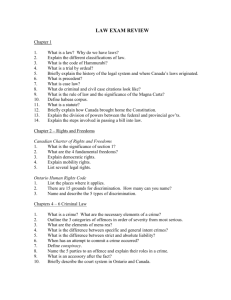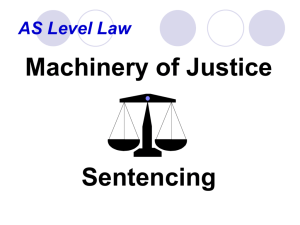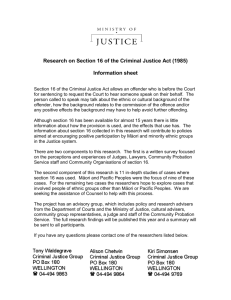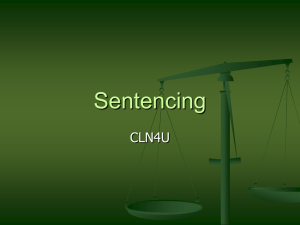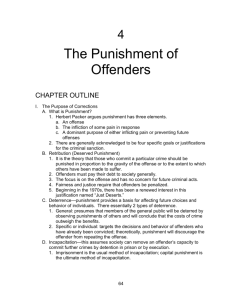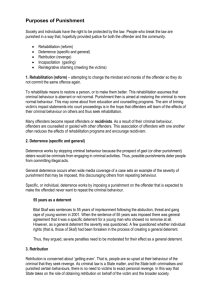Sentencing (Learning About Law, p
advertisement
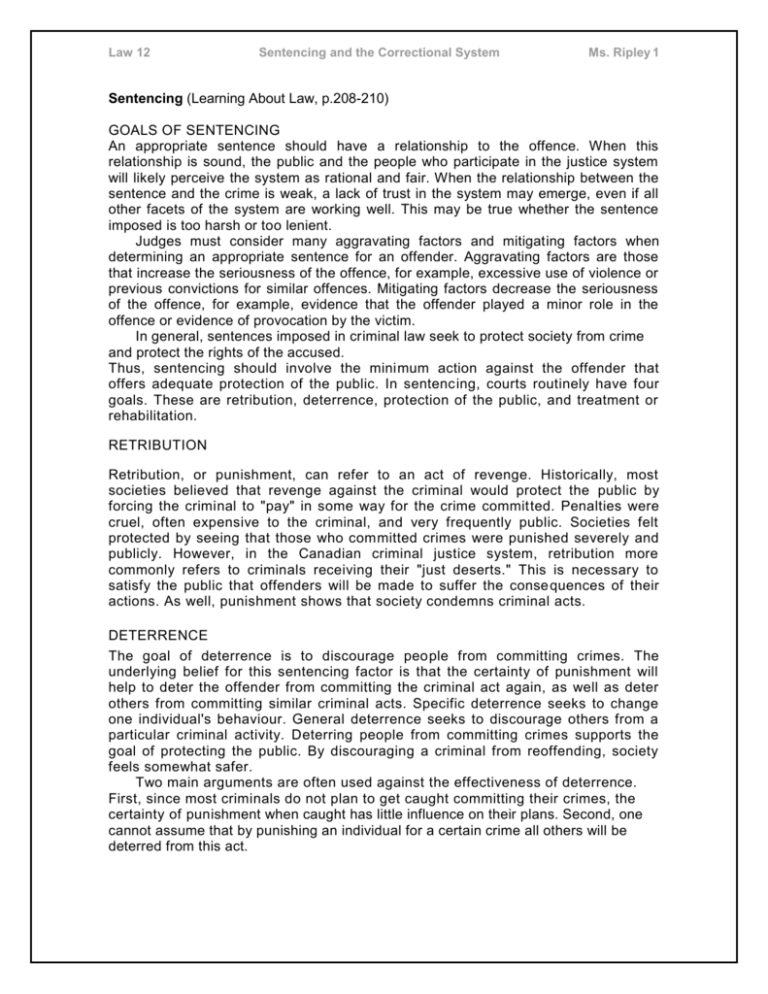
Law 12 Sentencing and the Correctional System Ms. Ripley 1 Sentencing (Learning About Law, p.208-210) GOALS OF SENTENCING An appropriate sentence should have a relationship to the offence. When this relationship is sound, the public and the people who participate in the justice system will likely perceive the system as rational and fair. When the relationship between the sentence and the crime is weak, a lack of trust in the system may emerge, even if all other facets of the system are working well. This may be true whether the sentence imposed is too harsh or too lenient. Judges must consider many aggravating factors and mitigating factors when determining an appropriate sentence for an offender. Aggravating factors are those that increase the seriousness of the offence, for example, excessive use of violence or previous convictions for similar offences. Mitigating factors decrease the seriousness of the offence, for example, evidence that the offender played a minor role in the offence or evidence of provocation by the victim. In general, sentences imposed in criminal law seek to protect society from crime and protect the rights of the accused. Thus, sentencing should involve the minimum action against the offender that offers adequate protection of the public. In sentencing, courts routinely have four goals. These are retribution, deterrence, protection of the public, and treatment or rehabilitation. RETRIBUTION Retribution, or punishment, can refer to an act of revenge. Historically, most societies believed that revenge against the criminal would protect the public by forcing the criminal to "pay" in some way for the crime committed. Penalties were cruel, often expensive to the criminal, and very frequently public. Societies felt protected by seeing that those who committed crimes were punished severely and publicly. However, in the Canadian criminal justice system, retribution more commonly refers to criminals receiving their "just deserts." This is necessary to satisfy the public that offenders will be made to suffer the conse quences of their actions. As well, punishment shows that society condemns criminal acts. DETERRENCE The goal of deterrence is to discourage people from committing crimes. The underlying belief for this sentencing factor is that the certainty of punishment will help to deter the offender from committing the criminal act again, as well as deter others from committing similar criminal acts. Specific deterrence seeks to change one individual's behaviour. General deterrence seeks to discourage others from a particular criminal activity. Deterring people from committing crimes supports the goal of protecting the public. By discouraging a criminal from reoffending, society feels somewhat safer. Two main arguments are often used against the effectiveness of deterrence. First, since most criminals do not plan to get caught committing their crimes, the certainty of punishment when caught has little influence on their plans. Second, one cannot assume that by punishing an individual for a certain crime all others will be deterred from this act. Law 12 Sentencing and the Correctional System Ms. Ripley 2 PROTECTION OF THE PUBLIC Protection of society is a key goal of sentencing. This includes not only protecting people and property, but also protecting public morality and individual rights. Segregation is one way to protect the public from criminal acts, and this is accomplished by imprisoning the offender for a long period of time, even for life. TREATMENT Treatment is also referred to as rehabilitation or reformation of the offender. It is an attempt to create a willingness to change and an awareness of the changes needed to form new behaviour patterns. Supporters believe that psychiatric and/or medical treatment will help the offender to not reoffend, thus protecting society In restoring the offender to a useful life, society is protected because future criminal activity is discouraged. For example, both provincial and federal corrections facilities have programs to help offenders overcome alcohol and drug abuse. Some of the more innovative programs in the corrections system include hunting and trapping programs for young Aboriginal offenders in the Northwest Territories, and community super vision programs. Focus 1. List reasons why people are sentenced for the crimes they commit. 2. In your own words, explain the meaning of the term "appropriate sentence." 3. What are the two main purposes of criminal law? How do these purposes apply to the definition of appropriate sentencing? 4. Why is the protection of the public the underlying consideration whenever a judge sentences an offender? Is this appropriate in your opinion? Explain. APPLY 1. Note the main goal of sentencing that is addressed by each of the following, and justify your answers: a. A 20-year prison sentence for a violent repeat offender. b. A sentence that requires an offender to remove the graffiti that she or he painted on the wall of a local business. c. A fine for speeding. d. A brief period of time in jail for obstructing justice by refusing to answer questions truthfully in court. e. An order to work as a volunteer in a food bank for an offender convicted of stealing from a grocery store. f. An order to pay compensation to a victim whose property was destroyed. g. A month in jail plus a large fine for refusing to pay child support to a spouse. h. An order that prevents an offender from being within 5 km of the residence of his or her previous assault victim. i. An order that prohibits an offender from owning or gaining access to firearms or explosives.

